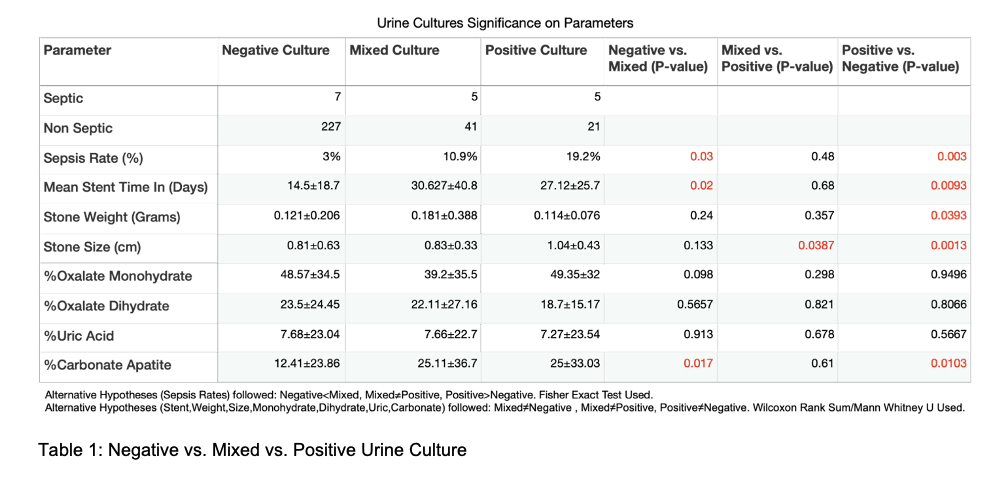Back
Poster, Podium & Video Sessions
Moderated Poster
MP05: Stone Disease: Basic Research & Pathophysiology
MP05-10: Mixing It Up: Are Patients With Mixed Urine Cultures at Higher Risk of Postoperative Sepsis After Ureteroscopy?
Friday, May 13, 2022
8:45 AM – 10:00 AM
Location: Room 225
Young Son*, Julia Scali, Stratford, NJ, Ian Madison, Philadelphia, PA, Benjamin Fink, Katelyn Klimowich, Dayna DeVincentz, Paul Chialastri, Thomas Mueller, Stratford, NJ

Young Son, DO
Resident
Jefferson New Jersey
Poster Presenter(s)
Introduction: Ureteroscopy with laser lithotripsy has been used for the treatment of ureteral calculi since the 1980s. Life-threatening urosepsis is one of the most severe complications of this procedure. The American Urological Association (AUA) recommends single-dose antibiotic prophylaxis prior to ureteroscopic stone removal. The significance of colonization in an asymptomatic patient is unknown at this time. Our objective is to determine if preoperative urine cultures with mixed flora on microbiology report, have a higher rate of postoperative sepsis than patients with negative cultures for uncomplicated elective ureteroscopy with laser lithotripsy.
Methods: A retrospective multi-institutional chart review was performed on 306 patients for which procedure code included elective ureteroscopy with lithotripsy from April 2018 until December 2020. Patients were excluded if the mixed urine cultures were treated with antibiotic therapy, inpatient setting, or had percutaneous nephrostomy or nephroureterostomy tubes. Mixed cultures were defined as mixed culture >10,000 CFU (colony forming unit) and positive cultures were defined as bacteria with >100,000 CFU.
Results: The overall sepsis rates were 3% with negative culture preoperatively, 10.9% with a mixed culture, and 19.2% with positive culture. There was a significant difference in carbonate apatite composition between mixed culture group and negative culture group (p=0.02) and positive culture group and negative culture group (p=0.01) (Table 1). There was an increased stent duration 38.4 days compared to 16.6 days in septic vs. non-sepsis group (p < 0.002). There were discordinate amount of carbonate apatite composition with 37.7% in the sepsis group compared to 14.2% in the non-sepsis group (p=0.003) (Table 2).
Conclusions: We conclude that there is 3.6 times more likely that postoperative sepsis patients had mixed cultures compared to negative cultures. Also, there was 2.7 times more carbonate apatite stone composition in postoperative sepsis group compared to non-sepsis group.
Source of Funding: None


Methods: A retrospective multi-institutional chart review was performed on 306 patients for which procedure code included elective ureteroscopy with lithotripsy from April 2018 until December 2020. Patients were excluded if the mixed urine cultures were treated with antibiotic therapy, inpatient setting, or had percutaneous nephrostomy or nephroureterostomy tubes. Mixed cultures were defined as mixed culture >10,000 CFU (colony forming unit) and positive cultures were defined as bacteria with >100,000 CFU.
Results: The overall sepsis rates were 3% with negative culture preoperatively, 10.9% with a mixed culture, and 19.2% with positive culture. There was a significant difference in carbonate apatite composition between mixed culture group and negative culture group (p=0.02) and positive culture group and negative culture group (p=0.01) (Table 1). There was an increased stent duration 38.4 days compared to 16.6 days in septic vs. non-sepsis group (p < 0.002). There were discordinate amount of carbonate apatite composition with 37.7% in the sepsis group compared to 14.2% in the non-sepsis group (p=0.003) (Table 2).
Conclusions: We conclude that there is 3.6 times more likely that postoperative sepsis patients had mixed cultures compared to negative cultures. Also, there was 2.7 times more carbonate apatite stone composition in postoperative sepsis group compared to non-sepsis group.
Source of Funding: None



.jpg)
.jpg)